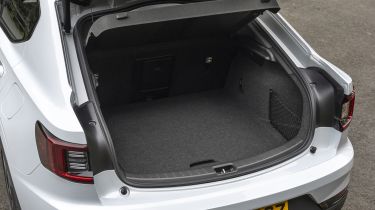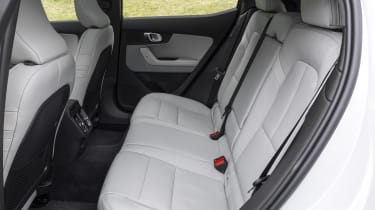Polestar 2 - Practicality, comfort and boot space
A comfortable cabin and a practical hatchback body style are plus points for the Polestar 2

The Polestar 2's interior quality is high, and the seats are comfortable enough to ensure you arrive relaxed at the end of a long journey.
Unlike the Tesla Model 3 or Hyundai Ioniq 6, the Polestar 2 uses a platform that has to accommodate both combustion-engined models and those with battery-electric powertrains. One consequence of this CMA architecture shared with the Volvo XC40 is the huge transmission tunnel, which compromises comfort for anyone sitting in the middle seat. Those up front may find their knees knocking against the high-set centre console.
During our group test between the Polestar 2, BMW i4 and Tesla Model 3 we found the Polestar’s interior storage to be the least impressive of the three. The door bins are shallow and the central cubby is quite small, while you’ll find two cup-holders under the centre armrest.
Size
The Polestar 2 measures 4,606mm in length, 1,859mm wide (excluding side mirrors) and stands 1,479mm tall. By comparison, the Tesla Model 3 is pretty much the same length, although not quite as wide and sits around 30mm lower. The Hyundai Ioniq 6 is even longer though, measuring 4,855mm from nose to tail, and stands 1,495mm tall and 1,880mm wide.
Leg room, head room & passenger space
There's a good amount of space inside the Polestar 2. Even though you feel more cocooned in the Polestar’s cockpit compared to other family EVs, those up front get plenty of head, leg and elbow room
Used - available now

2022 Peugeot
E-2008
21,779 milesAutomaticElectric
Cash £14,600
2020 Volkswagen
Tiguan
39,284 milesAutomaticPetrol2.0L
Cash £24,400
2020 Audi
A3 Sportback
38,198 milesManualPetrol1.5L
Cash £15,300
2023 Land Rover
Range Rover Evoque
25,475 milesManualDiesel2.0L
Cash £21,100Rear passenger space is a close match for the BMW i4, with a good amount of legroom on offer, plus foot space under the front seats. You get a set of air vents and two USB-C charging ports in the back, so your kids won’t have to squabble over who can charge their device on longer journeys. The optional glass roof does eat into headroom a touch, but even the tallest of occupants shouldn’t find it too intrusive. As we mentioned above, the large transmission tunnel doesn’t leave much space for anyone forced to take the middle seat.
There are three seats of ISOFIX mounting points in the Polestar hidden behind plastic covers. One is on the front passenger seat, while the other two are on the outer positions of the rear seats. During our testing, we noted that the rear door openings are smaller than we’d expect due in part to the sloping angle of the roof line, which doesn’t help when it comes to fitting a child seat.
Boot
The Polestar 2's boot space is a decent 405 litres, which extends to 1,095 litres with the rear seats folded. It has an advantage over the Tesla Model 3 and Hyundai Ioniq 6 in that it has a hatchback tailgate that opens up much wider than its American and Korean rivals, making it easier to load luggage. There is also an extra 41 litres of stowage in the car’s nose or ‘frunk’, although it’s only big enough to store the charging cables.
Towing
Every version of the Polestar 2 has a maximum towing capacity of 1,500kg, or 750kg if it’s an unbraked trailer. Polestar also offers a semi-electric retractable towbar as an optional extra. You will need to look into what towing mirror extensions you can get for the Polestar 2, because its frameless mirrors can’t accept the type that clamp onto the door mirror casing.









